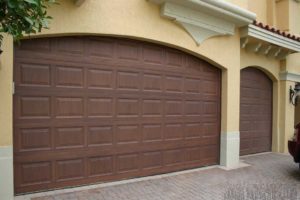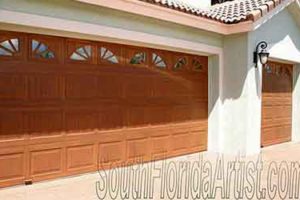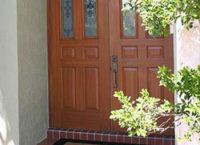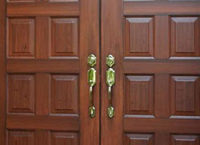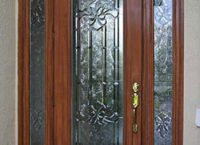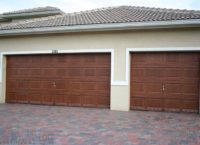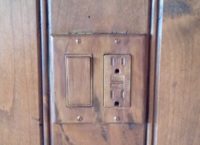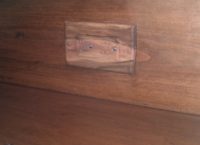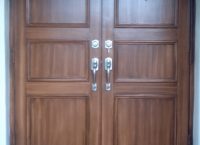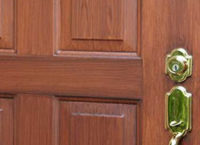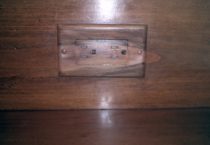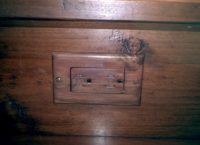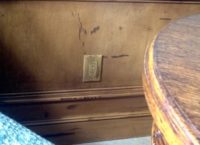The Art of Wood Graining
Wood graining that looks authentic is an art that takes years to master. Wood comes in many types, colors and variations. As in marblizing, it takes knowledge of the specific species of wood being created. The careful attention to color and pattern are very important in creating a selected species.
History of graining
The art of graining, also known as "faux bois" found its niche in 19th century England and France. For economic reasons wood was often imitated because of the trends of design at the time. Rosewood, mahogany and burl were the rare woods that were most often in demand. As artisan’s skills increased, designers saw the value in replicating these rare woods in doors and moldings being that it was far less expensive and virtually undetectable as being a replica.
The 20th century brought about conservation of these increasingly rare hardwoods. Many laws have been passed making it quite expensive or impossible to obtain. With this there was resurgence in the art of faux bois. Artisans with experience and extensive training have made it impossible to point out a real wood vs. faux bois. Many artists start with a simple grain ... perfect their hand with that grain and work their way to the more complicated burls and satinwood. Graining on moldings, doors, home elevators and furniture are often called for by contemporary designers.
Grained Metal Garage Doors
 A very popular application of faux wood graining is on garage and front entry doors that are often metal or fiberglass. Each surface is different ... some are embossed and others completely flat.
A very popular application of faux wood graining is on garage and front entry doors that are often metal or fiberglass. Each surface is different ... some are embossed and others completely flat.
Embossed garage doors can look wonderful once grained. There are limitations as to the amount of detail that the artist can create because of this embossing.
I've supplied a few examples of some doors that have been grained. It takes an average of 3 to 5 layers of transparent glazes to replicate the luster and depth of the species of wood being created.
Front Entries
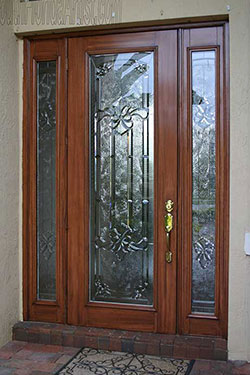 Front entries are treated similarly to the garage doors when being grained. Often more detail can be created here. The reason being that we are starting with a perfectly flat canvas (Sorry, I'm an artist, so I can call it a canvas).When starting with a flush surface, we have the opportunity to create our own pore grain.
Front entries are treated similarly to the garage doors when being grained. Often more detail can be created here. The reason being that we are starting with a perfectly flat canvas (Sorry, I'm an artist, so I can call it a canvas).When starting with a flush surface, we have the opportunity to create our own pore grain.
There are a number of ways to create a pore grain (they're secrets of the trade, so I can't tell you). Just kidding... Sometimes the pore grain is created thru flogging. A flogger is a long bristled specialty brush that creates a pretty amazing pore pattern. Another method to create a pore grain, especially in oak, is to use a check roller. It's an interesting tool that’s good at what it does. There are simpler tools that can also create a nice pore grain... steel wool; yep it sometimes does the job too.
I apologize if I'm getting too technical. I just think this is an important step in the process of creating a nicely grained door. It's most important because this is where your guests are going to get the closest view of the artwork that was created.
And if it's well done, ... hopefully they won't even notice that it's a work of art. It's just a beautifully stained wood door...that can stay between us.
***SPECIAL NOTE*** Any exterior wood graining has the issue of having to hold up the elements. I suggest a healthy clear coat that is proper to the system that was used in creating the graining. The homeowner also as to be a little vigilant as to what Mother Nature is doing to the finish. Once you start seeing the finish dull, ... It's time for a new clear coat. Once a year if you're in a tropical climate like South Florida. You'd probably be safe with a longer interval of clear coating. But I'd still do it to help protect your investment.
Interior Graining
WHEW!!!! We’re inside. Pardon me, I'm having flashbacks of working on those garage doors in the Floridian summer sun.
Interior graining ... this is where the artistry usually goes to another level. Exotic paneling in studys, columns and grained crown moulding.... great for hiding joints. Bannisters and fireplace mantels are also often grained. Once of the most dramatic changes that decorative graining can create is when it lands on the ceiling... be it, full planking or just grained beams. The end result is always "WOW". ALSO, what a better way to go "green". Many of these hardwoods take a life-time and more to grow. If we can create a finish that matches the real thing, why not do it. We can better control the final look of the finish and not have any surprise wild grains that nature often throws into a natural product.
Learn more about the process of wood graining here.
I hope I've left you a little better informed as to what decorative wood graining is about. If you have any questions about graining that I've not addressed here, feel free to contact me and I'll get you the answer... Even if I don't know the answer (I know people), I'll find out! (LOL)


